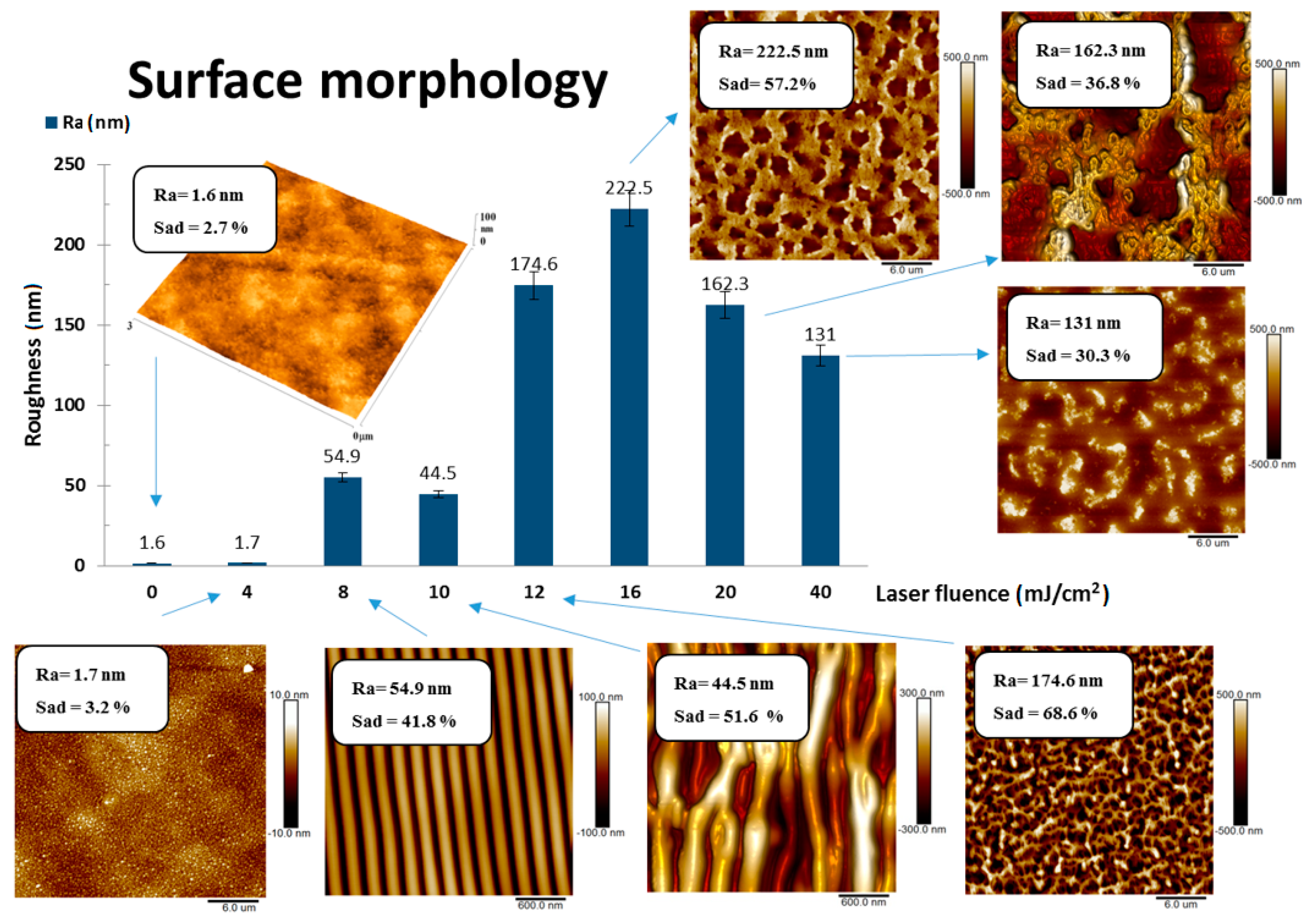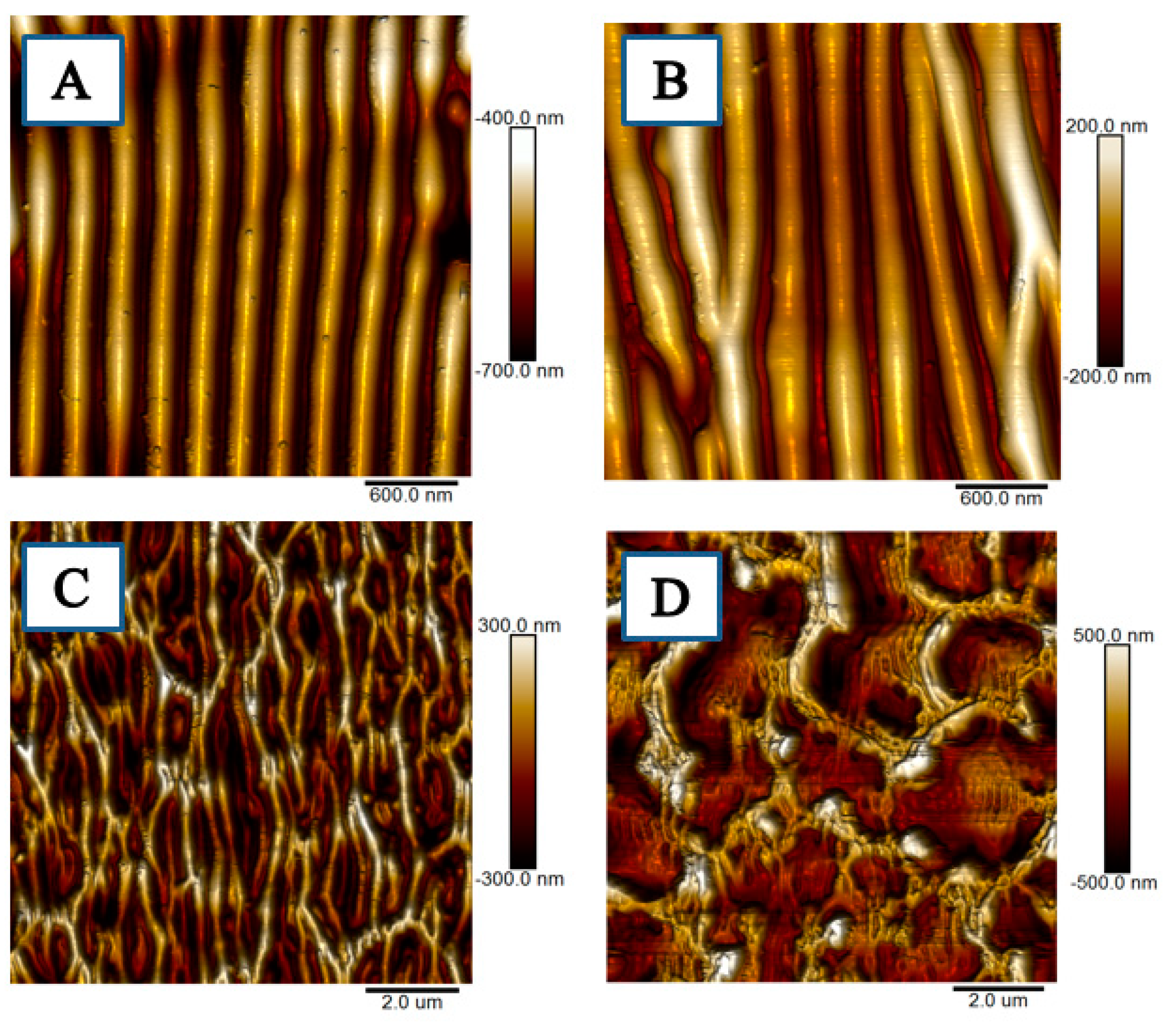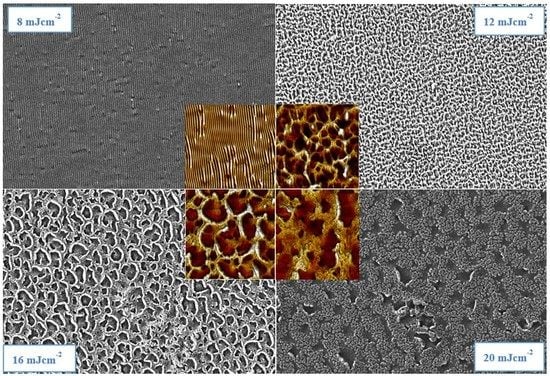LIPSS Structures Induced on Graphene-Polystyrene Composite
Abstract
1. Introduction
2. Materials and Methods
2.1. Materials, Procedures and Apparatus
2.2. Characterization Techniques
3. Results
3.1. Surface Roughness and Morphology
3.2. Electrical Properties and Wettability
3.3. Analysis of Surface Chemistry
4. Conclusions
Author Contributions
Funding
Conflicts of Interest
References
- Mark, J.E. Polymer data handbook, 2nd ed.; Oxford University Press: New York, NY, USA, 2009. [Google Scholar]
- Elashnikov, R.; Slepička, P.; Rimpelova, S.; Ulbrich, P.; Švorčík, V.; Lyutakov, O. Temperature-responsive PLLA/PNIPAM nanofibers for switchable release. Mater. Sci. Eng. C 2017, 72, 293–300. [Google Scholar] [CrossRef] [PubMed]
- Eslamian, M.; Zabihi, F. Ultrasonic Substrate Vibration-Assisted Drop Casting (SVADC) for the Fabrication of Photovoltaic Solar Cell Arrays and Thin-Film Devices. Nanoscale Res. Lett. 2015, 10, 462. [Google Scholar] [CrossRef] [PubMed]
- Soltani-Kordshuli, F.; Zabihi, F.; Eslamian, M. Graphene-doped PEDOT: PSS nanocomposite thin films fabricated by conventional and substrate vibration-assisted spray coating (SVASC). Eng. Sci. Technol. 2019, 19, 1216–1223. [Google Scholar]
- Olean-Oliveira, A.; Teixeira, M.F. Development of a nanocomposite chemiresistor sensor based on π-conjugated azo polymer and graphene blend for detection of dissolved oxygen. Sensors Actuators B Chem. 2018, 271, 353–357. [Google Scholar] [CrossRef]
- Slepička, P.; Michaljaničová, I.; Kasálková, N.S.; Kolska, Z.; Rimpelová, S.; Ruml, T.; Svorcik, V. Poly-l-lactic acid modified by etching and grafting with gold nanoparticles. J. Mater. Sci. 2013, 48, 5871–5879. [Google Scholar] [CrossRef]
- Slepička, P.; Michaljaničová, I.; Sajdl, P.; Fitl, P.; Svorcik, V. Surface ablation of PLLA induced by KrF excimer laser. Appl. Surf. Sci. 2013, 283, 438–444. [Google Scholar] [CrossRef]
- Slepička, P. Controlled biopolymer roughness induced by plasma and excimer laser treatment. Express Polym. Lett. 2013, 7, 950–958. [Google Scholar] [CrossRef]
- Michaljaničová, I.; Slepička, P.; Heitz, J.; Barb, R.; Sajdl, P.; Svorcik, V. Comparison of KrF and ArF excimer laser treatment of biopolymer surface. Appl. Surf. Sci. 2015, 339, 144–150. [Google Scholar] [CrossRef]
- Slepička, P.; Trostová, S.; Kasálkova, N.S.; Kolská, Z.; Sajdl, P.; Švorčík, V. Surface modification of biopolymers by argon plasma and thermal treatment. Plasma Process. Polym. 2012, 9, 197–206. [Google Scholar] [CrossRef]
- Bolle, M.; Lazare, S. Large scale excimer laser production of submicron periodic structures on polymer surfaces. Appl. Surf. Sci. 1993, 69, 31–37. [Google Scholar] [CrossRef]
- Rebollar, E.; Perez, S.; Hernandez, J.J.; Martín-Fabiani, I.; Rueda, D.R.; Ezquerra, T.A.; Castillejo, M. Assessment and Formation Mechanism of Laser-Induced Periodic Surface Structures on Polymer Spin-Coated Films in Real and Reciprocal Space. Langmuir 2011, 27, 5596–5606. [Google Scholar] [CrossRef] [PubMed]
- Rebollar, E.; Sanz, M.; Pérez, S.; Hernández, M.; Martín-Fabiani, I.; Rueda, D.R.; Ezquerra, T.A.; Domingo, C.; Castillejo, M. Gold coatings on polymer laser induced periodic surface structures: Assessment as substrates for surface-enhanced Raman scattering. Phys. Chem. Chem. Phys. 2012, 14, 15699–15705. [Google Scholar] [CrossRef]
- Borowiec, A.; Haugen, H.K. Subwavelength ripple formation on the surfaces of compound semiconductors irradiated with femtosecond laser pulses. Appl. Phys. Lett. 2003, 82, 4462. [Google Scholar] [CrossRef]
- Granados, E.; Martinez-Calderon, M.; Gomez, M.; Rodriguez, A.; Olaizola, S.M. Photonic structures in diamond based on femtosecond UV laser induced periodic surface structuring (LIPSS). Opt. Express 2017, 25, 15330. [Google Scholar] [CrossRef] [PubMed]
- Bäuerle, D.W. Laser Processing and Chemistry, 4th ed.; Springer: Berlin, Germany, 2011. [Google Scholar]
- Rebollar, E.; Castillejo, M.; Ezquerra, T.A. Laser induced periodic surface structures on polymer films: From fundamentals to applications. Eur. Polym. J. 2015, 73, 162–174. [Google Scholar] [CrossRef]
- Reinhardt, H.; Hillebrecht, P.; Hampp, N.A.; Kim, H.-C.; Kim, H. Photochemical Preparation of Sub-Wavelength Heterogeneous Laser-Induced Periodic Surface Structures. Adv. Mater. 2012, 24, 1994–1998. [Google Scholar]
- Dinca, V.; Alloncle, P.; Delaporte, P.; Ion, V.; Rusen, L.; Filipescu, M.; Mustaciosu, C.; Luculescu, C.; Dinescu, M. Excimer laser texturing of natural composite polymer surfaces for studying cell-to-substrate specific response. Appl. Surf. Sci. 2015, 352, 82–90. [Google Scholar] [CrossRef]
- Daskalova, A.; Nathala, C.S.; Kavatzikidou, P.; Ranella, A.; Szoszkiewicz, R.; Husinsky, W.; Fotakis, C. FS laser processing of bio-polymer thin films for studying cell-to-substrate specific response. Appl. Surf. Sci. 2016, 382, 178–191. [Google Scholar] [CrossRef]
- Turunen, S.; Kapyla, E.; Lähteenmäki, M.; Yla-Outinen, L.; Narkilahti, S.; Kellomäki, M. Direct laser writing of microstructures for the growth guidance of human pluripotent stem cell derived neuronal cells. Opt. Lasers Eng. 2014, 55, 197–204. [Google Scholar] [CrossRef]
- Kalachyova, Y.; Mares, D.; Lyutakov, O.; Koštejn, M.; Lapcak, L.; Svorcik, V. Surface Plasmon Polaritons on Silver Gratings for Optimal SERS Response. J. Phys. Chem. C 2015, 119, 9506–9512. [Google Scholar] [CrossRef]
- Kaimlová, M.; Nemogová, I.; Kolářová, K.; Slepička, P.; Švorčík, V.; Siegel, J. Optimization of silver nanowire formation on laser processed PEN: Surface properties and antibacterial effects. Appl. Surf. Sci. 2019, 473, 516–526. [Google Scholar] [CrossRef]
- Slepička, P.; Siegel, J.; Lyutakov, O.; Kasálková, N.S.; Kolská, Z.; Bačáková, L.; Švorčík, V. Polymer nanostructures for bioapplications induced by laser treatment. Biotechnol. Adv. 2018, 36, 839–855. [Google Scholar] [CrossRef] [PubMed]
- Mohan, V.B.; Lau, K.-T.; Hui, D.; Bhattacharyya, D. Graphene-based materials and their composites: A review on production, applications and product limitations. Compos. Part B Eng. 2018, 142, 200–220. [Google Scholar] [CrossRef]
- Novoselov, K.; Geim, A.K.; Morozov, S.; Jiang, D.; Zhang, Y.; Dubonos, S.V.; Grigorieva, I.V.; Firsov, A.A. Electric Field Effect in Atomically Thin Carbon Films. Science 2004, 306, 666–669. [Google Scholar] [CrossRef]
- Yang, G.W. Laser Ablation in Liquids: Applications in the Synthesis of Nanocrystals. Prog. Mater. Sci. 2007, 52, 648–698. [Google Scholar] [CrossRef]
- Intartaglia, R.; Daş, G.; Bagga, K.; Gopalakrishnan, A.; Genovese, A.; Povia, M.; Di Fabrizio, E.; Cingolani, R.; Diaspro, A.; Brandi, F.; et al. Laser synthesis of ligand-free bimetallic nanoparticles for plasmonic applications. Phys. Chem. Chem. Phys. 2013, 15, 3075–3082. [Google Scholar] [CrossRef]
- Barberio, M.; Antici, P. Laser-Plasma Driven Synthesis of Carbon-Based Nanomaterials. Sci. Rep. 2017, 7, 12009. [Google Scholar] [CrossRef]
- Rodríguez-Beltrán, R.I.; Hernandez, M.; Paszkiewicz, S.; Szymczyk, A.; Rosłaniec, Z.; Ezquerra, T.A.; Castillejo, M.; Moreno, P.; Rebollar, E. Laser induced periodic surface structures formation by nanosecond laser irradiation of poly (ethylene terephthalate) reinforced with Expanded Graphite. Appl. Surf. Sci. 2018, 436, 1193–1199. [Google Scholar] [CrossRef]






| Laser Modified Samples (W(GNP) = 10%) | Non-Modified Samples | ||||
|---|---|---|---|---|---|
| E (mJ cm−2) | C (wt. %) | O (wt. %) | GNP (wt. %) | C (wt. %) | O (wt. %) |
| 8 | 89.03 ± 0.08 | 10.97 ± 0.08 | 10 | 99.29 ± 0.03 | 0.71 ± 0.03 |
| 16 | 92.89 ± 0.07 | 7.11 ± 0.07 | 20 | 99.30 ± 0.04 | 0.70 ± 0.04 |
| 20 | 90.98 ± 0.07 | 9.02 ± 0.07 | 30 | 99.28 ± 0.07 | 0.72 ± 0.07 |
| 40 | 91.32 ± 0.04 | 8.68 ± 0.04 | 40 | 99.34 ± 0.04 | 0.66 ± 0.04 |
© 2019 by the authors. Licensee MDPI, Basel, Switzerland. This article is an open access article distributed under the terms and conditions of the Creative Commons Attribution (CC BY) license (http://creativecommons.org/licenses/by/4.0/).
Share and Cite
Fajstavr, D.; Neznalová, K.; Švorčík, V.; Slepička, P. LIPSS Structures Induced on Graphene-Polystyrene Composite. Materials 2019, 12, 3460. https://doi.org/10.3390/ma12213460
Fajstavr D, Neznalová K, Švorčík V, Slepička P. LIPSS Structures Induced on Graphene-Polystyrene Composite. Materials. 2019; 12(21):3460. https://doi.org/10.3390/ma12213460
Chicago/Turabian StyleFajstavr, Dominik, Klára Neznalová, Václav Švorčík, and Petr Slepička. 2019. "LIPSS Structures Induced on Graphene-Polystyrene Composite" Materials 12, no. 21: 3460. https://doi.org/10.3390/ma12213460
APA StyleFajstavr, D., Neznalová, K., Švorčík, V., & Slepička, P. (2019). LIPSS Structures Induced on Graphene-Polystyrene Composite. Materials, 12(21), 3460. https://doi.org/10.3390/ma12213460





